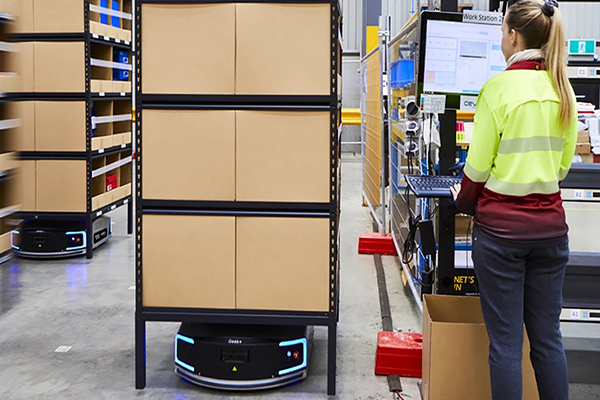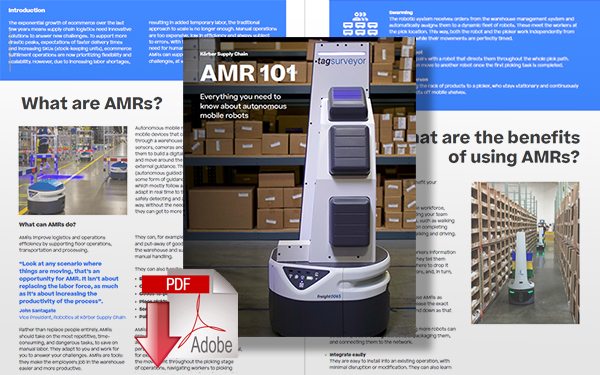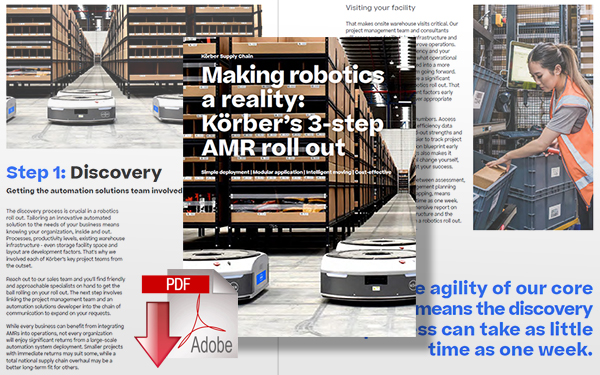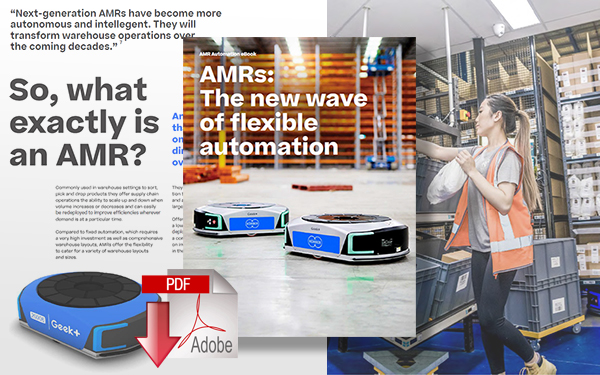How Autonomous Mobile Robots Can Solve Global Warehouse Fulfillment Challenges
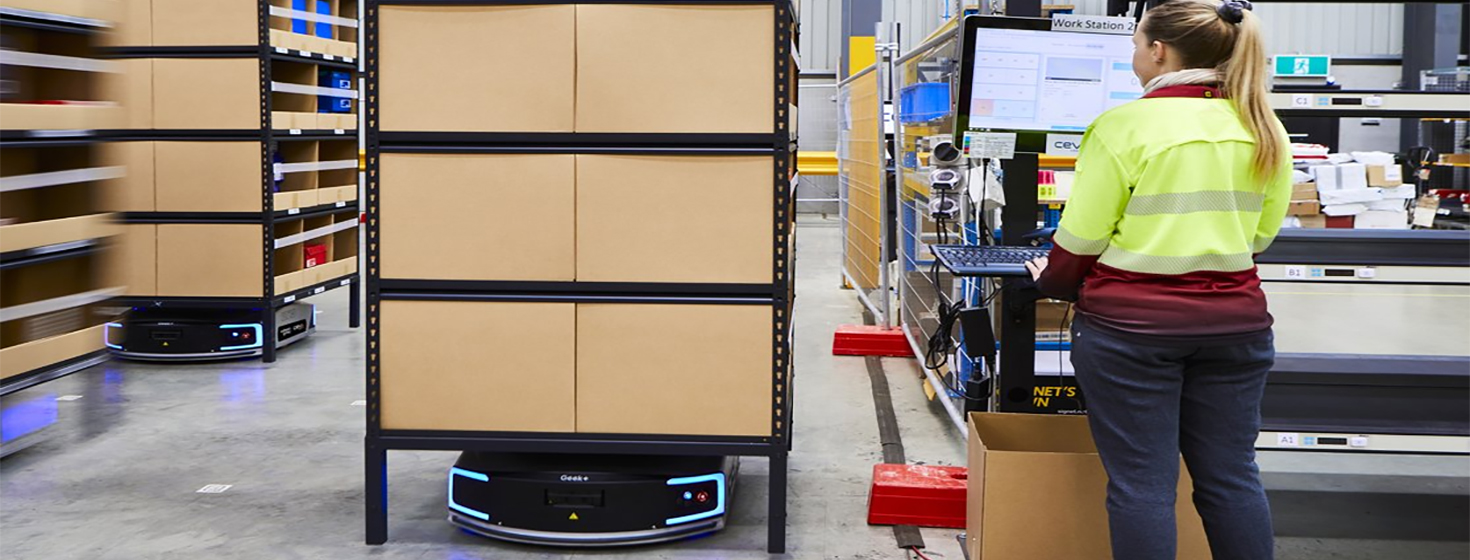
How autonomous mobile robots technology is increasing productivity in the warehouse and revolutionizing the factory floor, enabling the increased speed of fulfillment while lowering labor costs.
Autonomous Mobile Robots
The meteoric rise of eCommerce and the popularity of distribution sites like Amazon continue challenging supply chains to deliver products faster while keeping customer costs low, all while offering same-day or next-day delivery.
Global eCommerce sales are projected to increase 26.7% year-over-year to $4.891 trillion in 2021 – up from $3.351 trillion in 2019.
This rapid eCommerce fulfillment, along with increasing SKUs and more drastic peaks, challenges many warehouses to keep pace with expectations (and the competition). These are just a few reasons why so many warehouses like yours are looking to invest in automated solutions – and in particular, autonomous mobile robots (AMRs).
AMRs are revolutionizing the factory floor, enabling the increased speed of fulfillment the eCommerce environment requires, while lowering labor costs and increasing efficiency.
Highly flexible and scalable, AMRs use sensors cameras, and safety mechanisms to build a digital map of their environment and move around warehouses guidance-free.
Let’s take a look at some use cases for deploying AMRs in the warehouse along with the benefits this automated equipment can bring to your supply chain, too.
Increase Pick Rates, Decrease Labor Costs
Evo, a leading eCommerce sports gear and apparel retailer, invested in AMRs to help meet 2020 holiday peak challenges. Before the technology investment, employees picked about 35 units per hour (UPH).
After adding AMRs, that number increased to 90 UPH on average and enabled productivity to increase by 40% during peak season – all while using less staff and enabling workers to remain socially distant before the COVID-19 vaccine was widely available.
In this case, Evo didn’t want to reconfigure its warehouse and wanted to scale quickly, so AMRs became the best solution (watch the video above).
In many areas of the world, including the United States and Europe, warehouses have experienced issues attracting and retaining employees long before the pandemic, particularly in the cold storage industry. In other areas of the world – namely the Asia-Pacific region – an adequate pool of workers exists, but labor costs are exorbitantly high, and so is real estate.
In fact, we have a client in the Philippines using 250 goods-to-person and sortation AMRs in its three-level mezzanine warehouse to help offset high labor costs and fulfill orders quickly.
Redeploy Workforce, Improve Throughput
Interestingly, most companies investing in AMRs don’t necessarily use them to cut labor. AMRs take over time-consuming repetitive tasks, enabling you to redeploy workers elsewhere in the warehouse.
Robots and people move and work together on the warehouse floor, where the AMR brings the product or unit of products to the employee, known as goods-to-person. They also handle bulk material movement, components shuttling, piece picking, pallet picking, and sortation.
Enjoy Benefits of AMRs
AMRs, which complement other warehouse technology like voice-directed work and conveyors, have several benefits to your operations, including:
- Enhanced efficiency – workers can pick more frequently and have the ability to fulfill multiple orders simultaneously.
- Increased capacity – automating low-value tasks like pushing items around enables workers to perform higher-value activities.
- Improved productivity – faster turnabout, including processing more picks, leads to better throughput and increased revenue.
- Reduced errors – Robots give workers information about the item they’re picking, such as where it’s found, where to drop it, and what it looks like, decreasing the likelihood employees will select the wrong product.
- Boosted integrability – These smart robots, which learn from their surroundings and adapt movements, accordingly, are simple to add to your existing operations, with minimal disruptions or modifications.
- Lowered costs – AMRs are far more affordable than traditional automation solutions and can help mitigate labor expenses.
And since AMRs are scalable, they adjust to your business needs and warehouse environment. They can become permanent fixtures or rolled when needed and stored when not in use.
Choose a Provider that will Help Improve Workflow
Increasingly, we have found customers and prospects are interested not only in AMRs but also in finding a technology provider that understands the workflow of a warehouse or distribution center. Before selecting a solution, the provider should solicit answers regarding picking workflow, receiving goods processes, replenishing the grid, consolidating orders, taking products to the next station, and so on.
Remember, when investing in AMRs – or any automated solution – it’s more than just a robot deployment. It’s a workflow deployment. As such, make sure you choose a technology provider well-versed and experienced in AMRs but also in designing an entire warehouse or DC – everything from inbound right through to outbound. You should consider partnering with a provider interested in helping you plan for an AMR-enabled warehouse or DC now and in the future.
About the Author
Nishan Wijemanne is Managing Director APAC at Körber Supply Chain Software and Global Leader for autonomous mobile robot (AMR) solutions. He leads and drives the growth and success of Voice, Vision, Mobility, robotics, and Software competencies at Körber for the region while spearheading the strategic growth for AMR solutions excellence across the globe.
Related Resources
AMR 101 - Everything You Need To Know About Autonomous Mobile Robots
Autonomous Mobile Robots improve logistics and operations efficiency by supporting floor operations, transportation, and processing, and rather than replace people entirely, AMRs should take on the most repetitive, time-consuming, and dangerous tasks, to save on manual labor. Download Now!
Making Robotics a Reality: Körber’s 3-Step AMR Roll Out
In this paper, we describe a 3-step approach to rolling out autonomous mobile robots: simple deployment, modular applications, intelligent moving, and cost-effectiveness. Download Now!
AMRs: The New Wave of Flexible Automation
In this ebook we look at some of the barriers to entry for automation, the various use cases of agile and flexible autonomous mobile robots, AMRs, and some of the latest technology available today. Download Now!
More Resources from Körber Supply Chain
Related: Elevate Americas Virtual Conference
Article Topics
Korber Supply Chain News & Resources
Unified Control System - Intelligent Warehouse Orchestration The Future of Order Fulfillment NECS and Körber to Establish Largest Automated Freezer Warehouse in Vietnam Fit & Fast: Titan Brands’ Adoption of Tech Accelerates Supply Chain Efficiency An Inside Look at Dropshipping Looking ahead – The future of Supply Chains Supply Chain Imperatives 2024 and Beyond More Korber Supply ChainLatest in Warehouse|DC
European Parliament Passes Law on Supply Chain Accountability Transforming Warehousing with AI: Five Key Reasons to Adopt Now Talking Supply Chain: Understanding the FTC’s ban on noncompetes North Carolina Welcomes Amazon’s Newest Mega-Warehouse SAP Unveils New AI-Driven Supply Chain Innovations U.S. Manufacturing is Growing but Employment Not Keeping Pace Maximize Warehouse Space with Mezzanine Automation: Expert Tips More Warehouse|DC